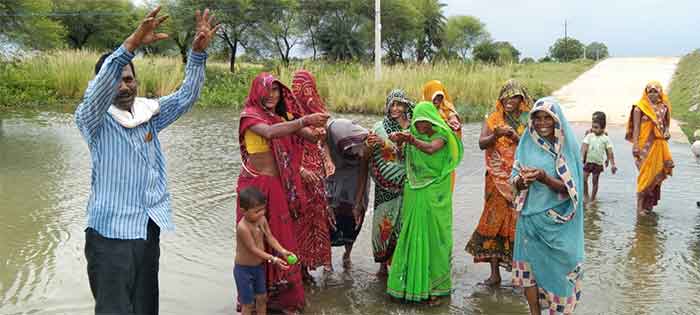
The dalit hamlet of Bhanwarpur village is an extremely poor rural settlement of Naraini block, Banda district (Uttar Pradesh). Most of the households here have very small holdings, or else are entirely landless. Survival has become increasingly difficult. Hence people have been migrating to distant places like Delhi and Agra.
Economic difficulties were accentuated by ecological decay. A river which flows near this village named Gharar dried up due to a number of factors including faulty policies. This river later merges into Bagain river, a part of the Yamuna river system. Soon a lot of weeds also appeared in the river flow area. Due to its drying up, people of Bhawanwarpur were denied irrigation. Farm animals could not quench their thirst. Hence survival in this and several other villages served by this river became more difficult. During rains the water which flowed in this river now flowed towards the habitation. This made the situation more difficult in the rainy season as well in the dry season in Bhanwarpur and nearby villages, and the drift towards migrant labor increased further.
After the COVID related lockdown was announced, many migrant workers started returning to the village after walking long distances. These migrant workers had to return in very difficult conditions without any money and savings as they had to leave in a hurry. They were extremely tired, without money and livelihood, and clueless about the future. In such conditions depressive feelings came easily.
In such a situation came the idea—instead of idling or even lapsing into depression why not use this opportunity of being together in village to make some long-lasting contribution to the development and welfare of village by making efforts for the revival of the dried-up, lost Gharar river which was once a life-line for this village. This thinking was spread and encouraged by Vidyadham Samiti (VDS), a voluntary organization which had been working in this and nearby villages with a lot of commitment for some years.
So about 52 returned migrant workers, including women, formed a committee and pushing aside their tiredness and sadness decided to take up the voluntary work of cleaning the river-flow site. They worked with commitment, often eating their food at the work-site to save time in coming back to village. VDS helped to keep up the spirit by helping to set up a sort of kitchen near the work-site. A great collective spirit grew, as people sang songs while contributing their voluntary labor (shramdaan). It was a very remarkable achievement that those who were in such great poverty themselves were contributing so much voluntary, unpaid labor day after day for the rejuvenation of a river.
The workers went on with these efforts for nearly a month, ignoring their personal problems. They cleaned up the thick growing weeds, locally called besharm, and then kept digging till they came in contact with water. A cry of joy went up as water of the lost river started appearing and cattle quickly gathered to quench their thirst.
As the news about the achievement spread and was covered in the media, some narrow-minded officially hastened to claim credit and set up boards describing this as NREGA work. When workers protested that this was their voluntary work, they were threatened and victimized by removing the names of some of them from the list of beneficiaries of government schemes like housing, as this writer was told at the time of visiting this village. This was the first punishment for the dalit villagers who had done some truly great work.
To the credit of the administration, however, it must be added that while the village workers could only cover only one stretch of the river, the administration added to this effort by its further efforts and thereby a much wider area extending beyond this village to some other villages can also benefit. As a result of this combined effort of villagers and the administration, so many villagers are able to get higher yields and even some land which was almost completely unproductive earlier is now giving good crops.
However in its overenthusiasm the administration has also created a structure which can lead to very destructive flooding of the village. Hence worried villagers are in the process of approaching the administration to remove this structure before the next big rains come so that the village can be saved from impending man-made disaster. At the time of this writer’s visit, all the residents, men and women, of the dalit hamlet present at a group meeting said with one voice that this is indeed a very big threat and urgent action for the safety of the village should be taken as early as possible.
Of course this is only a beginning and much more work in several villages will have to be done before the river can be revived. But the achievement of these tired and weak returned migrant workers within about a week reveals the enormous potential of what can be achieved for sustainable rural development if the dormant potential of these workers can be tapped adequately and properly.
Bharat Dogra is a senior award-winning journalist. He is Honorary Convener, Campaign to Save Earth Now. His recent books include Planet in Peril, Protecting Earth for Children, When the Two Streams Met ( freedom movement of India) and Man over Machine ( Gandhian Ideas for Our Times).








































